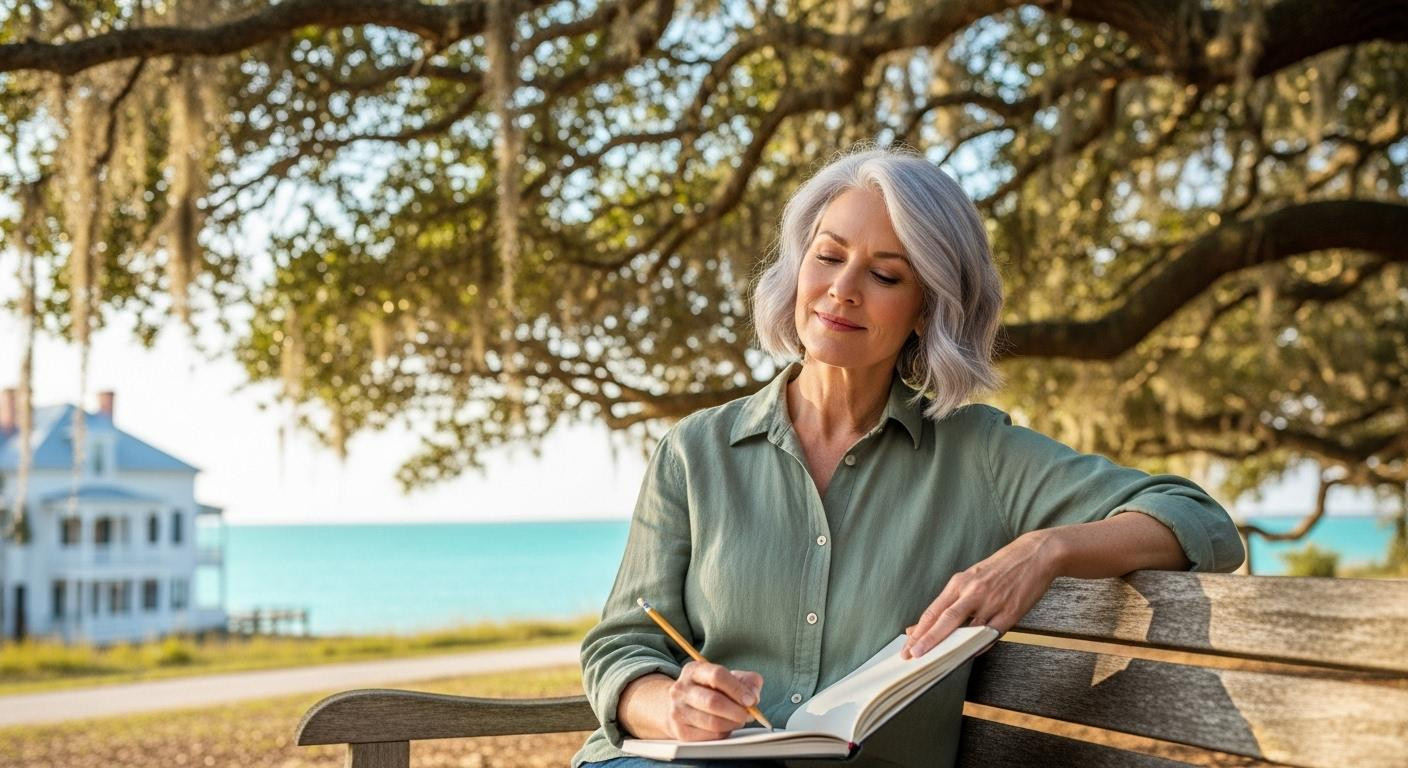Dawn breaks over Fairhope’s Municipal Pier as soft golden light touches Mobile Bay. An artist sketches quietly on a bench where Spanish moss drapes ancient oaks. Three days ago, Southern coastal towns meant crowded beaches and chain restaurants. Now, standing where 130-year-old utopian ideals still shape daily life, something fundamental shifts in how you see small-town America.
The storybook scene that greets you at dawn
Fairhope Avenue unfolds like pages from a carefully preserved novel. Victorian cottages line flower-bordered streets where magnolias perfume the morning air. White clapboard buildings catch the gentle light while wrap-around porches invite unhurried conversations.
The quarter-mile pier stretches into Mobile Bay’s calm waters. Pastel storefronts in the historic downtown create a timeless Main Street atmosphere that feels both authentic and dreamlike. Craftsman bungalows nestle beneath moss-draped oaks that have witnessed over a century of idealistic community building.
At 10 feet above sea level, Fairhope’s 17 square miles spread along Mobile Bay’s eastern shore. The town’s 22,000 residents maintain gardens that bloom year-round in Alabama’s subtropical climate. Summer temperatures reach 90°F while mild winters rarely drop below 45°F.
The utopian dream that still shapes this town
What transforms visitors goes deeper than architectural charm. Fairhope remains one of only two Single Tax colonies in America, a living experiment that began in 1894.
The 1894 single tax colony that defied convention
Twenty-eight idealists from Des Moines, Iowa traveled south seeking Henry George’s vision of economic fairness. They purchased clear-cut wasteland for $5.50 per acre on Mobile Bay’s high bluffs. The Fairhope Single Tax Corporation still owns approximately 4,000 acres today.
Residents lease land through 99-year renewable agreements rather than owning it outright. Whether you build a cottage or mansion, property taxes remain the same. This radical approach prioritizes community benefits over private speculation, creating the peaceful atmosphere visitors experience today.
How victorian architecture preserved a century of idealism
The National Register Historic District protects structures that embody the founders’ aesthetic vision. Victorian cottages and Craftsman bungalows maintain original details through strict preservation standards. Decorative woodwork and wide porches create architectural continuity that makes the entire downtown feel like stepping back in time.
The Single Tax Corporation gifted the beachfront park, Henry George Park, and the iconic pier to the city in the 1930s. These communal spaces reflect the founders’ belief that natural beauty belongs to everyone.
What transforms visitors beyond the postcard views
Fairhope’s 1.2 million annual visitors discover something rarer than scenic beauty. They experience a community where idealism created lasting cultural depth.
The artists’ colony that bloomed in the 1970s
Creative professionals discovered Fairhope’s unhurried pace and affordable living in the 1970s. The Eastern Shore Art Center now anchors a thriving arts district where galleries and studios cluster along downtown streets. Monthly First Friday Art Walks draw locals and visitors who browse original paintings, pottery, and handcrafted jewelry.
Artists serve as keepers of the utopian spirit, creating work inspired by the bay’s natural beauty and the town’s philosophical foundations. Their presence adds intellectual vibrancy that distinguishes Fairhope from typical coastal destinations.
Gulf seafood and southern tables locals protect
The Fairhope Store serves shrimp and grits using Gulf Coast catches landed that morning. Farm-to-table restaurants celebrate regional ingredients while maintaining affordable pricing that reflects community values rather than tourist exploitation. Average meal costs range from $15-25 per person.
The Thursday farmers’ market operates seasonally in spring and fall, connecting residents with local producers. Families gather here as their grandparents did, maintaining social traditions that strengthen community bonds across generations.
The pace that resets your internal clock
Walking Fairhope’s pier at sunset requires no agenda. Evening light turns Mobile Bay golden while rocking chairs face the water in silent invitation. The unhurried rhythm mirrors the bay’s gentle lapping against pier supports.
Business hours reflect local priorities rather than tourist demands. Shops close early enough for owners to enjoy family dinners. The town’s walkable 0.5-mile downtown encourages strolling conversations that would feel rushed elsewhere.
Traffic moves slowly not from congestion but from drivers who wave to neighbors. This measured pace reflects the founders’ belief that community life requires time for human connection.
Your questions about Fairhope, Alabama answered
When should I visit to experience Fairhope like locals do?
April through May and September through October offer mild temperatures between 65-80°F with fewer crowds than summer peak season. November brings fall colors and tranquility when most tourists have departed. Avoid June through August when temperatures reach 90°F and visitor numbers peak.
What makes Fairhope different from other gulf coast towns?
The Single Tax Corporation’s communal land philosophy creates a fundamentally different relationship between residents and place. Unlike Gulf Shores’ 6 million annual visitors seeking beach resorts, Fairhope’s 1.2 million guests discover a community where Victorian preservation and artistic density reflect 130 years of idealistic community building.
How much does a weekend in Fairhope actually cost?
Boutique bed-and-breakfasts average $150-250 per night compared to Gulf Shores resorts at $300-400. Local restaurants cost 10-15% below national coastal averages. Pier access, beach walks, and art gallery browsing remain free. Most visitors spend $200-300 total for a transformative weekend experience.
Evening light turns the pier golden as a fisher casts into still water. Three empty rocking chairs face Mobile Bay. Spanish moss sways in the coastal breeze. Your breathing slows to match the water’s gentle rhythm.
